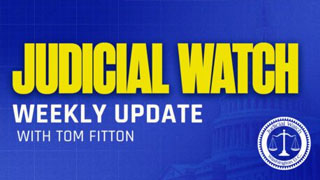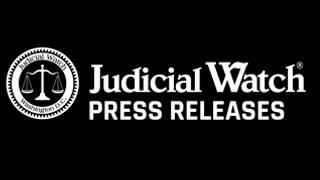

Fauci “Mutant” Viruses EXPOSED


Records Show EcoHealth/Wuhan Research to Create Coronavirus ‘Mutants’
Biden Justice Department Refuses to Reveal Names of Special Counsel’s Staff
Hearing for Mother Who Requested School Board COVID Records
FBI Stonewalls Public Record Request Involving Chinese Police Station in NY
Records Show EcoHealth/Wuhan Research to Create Coronavirus ‘Mutants’
Judicial Watch uncovered smoking gun document on our government’s entanglement in coronavirus “mutant” gain-of-function research in Chinese labs.
Our team received 552 pages of records that include the initial grant application and annual reports to the National Institutes of Health (NIH) from EcoHealth Alliance describing the aim of its work with the Wuhan Institute of Virology in China to create mutant viruses “to better predict the capacity of our CoVs [coronaviruses] to infect people.”
These and other documents strongly suggest that U.S. funding in China and elsewhere for mutant virus, gain-of-function research may have been responsible for the emergence of the COVID pandemic in Wuhan. This gain-of-function scandal should be the subject of criminal investigations.
Judicial Watch obtained the records from the Department of Health and Human Services (HHS) through a Freedom of Information Act (FOIA) request in December 2021 for:
All reports submitted by EcoHealth Alliance to NIH or its sub-agencies related to NIH Grant No. 1R01A|110964 titled “Understanding the Risk of Bat Coronavirus Emergence” during the term of the grant.
Eco Health planned to sequence the spike protein from coronaviruses obtained from bats for the purpose of “creating mutants to identify how significantly each would need to evolve to use ACE2,” which is explained as “the receptor to gain entry to human cells.”
Here are the details revealed in the documents.
In the initial “Application for Federal Assistance” submitted on June 5, 2013, by EcoHealth Alliance, a section is titled “Specific Aims,” which notes the intention to create mutant bat viruses and “predict the capacity of our CoVs [coronaviruses] to infect people:”
To understand the risk of zoonotic CoV [coronavirus] emergence, we propose to examine 1) the transmission dynamics of bat-CoVs across the human-wildlife interface; and 2) how this process is affected by CoV evolutionary potential, and how it might force CoV evolution. We will assess the nature and frequency of contact among animals and people in two critical human-animal interfaces: live animal markets in China and people who are highly exposed to bats in rural China.
“Specific Aim 3” discusses “Testing predictions of CoV inter-species transmission:”
We will test our models of host range (i.e. emergence potential) experimentally using reverse genetics, pseudovirus and receptor binding assays, and virus infection experiments in cell culture and humanized mice. With bat-CoVs that we’ve isolated or sequenced, and using live virus or pseudovirus infection in cells of different origin or expressing different receptor molecules, we will assess potential for each isolated virus and those with receptor binding site sequence to spill over. We will do this by sequencing the spike (or other receptor binding/fusion) protein genes from all our bat-CoVs, creating mutants to identify how significantly each would need to evolve to use ACE2, CD26/DPP4 (MERS-CoV receptor) or other potential CoV receptors.
In the continuing discussion of the aims of the research, the report states:
In vitro [outside the body] cell lines & Humanized mouse model: We have developed primary cell lines and transformed cell lines from 9 bat species using kidney, spleen, heart, brain and intestine. We have used these for virus isolation, infection assays and receptor molecule gene cloning. We also have a large number of cell lines from humans and animals that we will use for virus infectivity assays. We have obtained a letter of support from Dr Ralph Baric, who is keen to collaborate with us initially to infect his humanized mouse model with our bat SL-CoV [SARS-Like Coronavirus] that uses ACE2, and subsequently to use other CoVs that we identify …
***
The results will provide information whether bat-CoVs could use known bat and human ACE2, DPP4 or other known CoV receptors to enter cells, and allow us to determine critical receptor binding sites, viral host range, and to better predict the capacity of our CoVs to infect people. [Emphasis in original]
EcoHealth Alliance’s $3.3 million grant to fund a project titled “Understanding the Risk of Coronavirus Emergence” was initially to run from October 1, 2013, to September 30, 2018. The first “Project/Performance Site Location” is the Wuhan Institute of Virology. Three other Chinese sites follow: East China Normal University in Shanghai, Yunnan Institute of Endemic Disease Control and Prevention in Dali, and the Center for Disease Control and Prevention of Guangdong in Guangzhou.
On May 27, 2014, the NIH awarded EcoHealth Alliance $3,086,735 over five years for “Understanding the Risk of Bat Coronavirus Emergence.”
An EcoHealth Alliance grant application, received by the NIH on June 5, 2013, includes a list of “Senior/Key Personnel” including Shi Zhengli and Zhang Yun-Zhi of the Wuhan Institute of Virology (WIV); Peter Daszak, CEO of EcoHealth Alliance; and other Chinese scientists, including Ke Changwen of the Chinese “CDC and Prevention of Guangdong Province.”
A section of the EcoHealth Alliance application titled “EcoHealth Alliance Budget Justification” describes some of the work to be conducted by EcoHealth scientists in China:
A research scientist will be hired at 12 months time per year to provide direct assistance and oversight of field activities in China; maintain equipment and logistics; and coordinate animal and human sample shipment to the labs in China and in the US.
***
Once we secure IRBs [Institutional Review Boards] for human sampling in Y1 [Year 1], we will hire three medical officers from China provincial CDCs [Centers for Disease Control] as consultants to work in Guangxi, Hunan, and Fujian during Y2-Y5. These medical officers will be responsible for IRB approved human sampling as well as maintaining cold chain for storage and shipping samples.
***
Dr. Zhengli Shi, Senior Virologist. [Redacted] per year in Y1 -Y5. Dr. Shi will oversee the coronavirus screening for all samples collected in China. She will work with the PI [Principal Investigator], Co-Investigators, and Senior/Key Personnel to analyze data and write manuscripts. She will also coordinate data and material sharing with the co-investigators.
In a budget calculation for the year 2014-15, the Wuhan Institute of Virology as a sub-awardee of the grant was allocated to receive $128,718 in direct costs and $10,297 in indirect costs from NIH. The salaries of Shi Zhengli and a Wuhan Institute of Virology colleague Ge Xingyl are redacted from the budget. Over the five years of the grant, the Wuhan lab was to receive $749,976.
A section of the grant award titled “Wuhan Institute of Virology Budget Justification, Subaward” discusses “Other Direct Costs:”
RNA Extractions
We will be running RNA extractions for 1,000 bats per year (three sample per bat: oral, anal, and blood) in each year … Extracted RNA per animal will be pooled.
***
DNA Sequencing
In each year of the project, DNA sequencing will be performed on 3,200 samples at a cost of $2.91 per reaction….
Laboratory Supplies
We request support for in vitro infection experiments using pseudoviruses carrying the spike proteins (wild type or mutants) or live viruses in cell lines of different origins, binding affinity assays between the spike proteins (wild types or mutants) and different cellular receptor molecules, and humanized mouse experiments.
The Year 2 annual report for the bat coronavirus project, budget period June 1, 2016, to May 31, 2017, under “Specific Aim 3,” states:
Testing predictions of CoV inter-species transmission. The following experiments will be undertaken in Year 2:
- Humanized mice with human ACE2 receptors will be infected with WIV1 and the two rescued chimeric SARS-like coronaviruses to determine the tissue tropism and pathogenicity of bat SL-CoV.
- Isolation of novel bat coronaviruses. Live virus or pseudovirus will be used to infect cells of different origin or expressing different receptor molecules. Spillover potential for each isolated virus will be assessed.
- An infectious clone of full-length MERS-CoV [Middle East Respiratory Syndrome coronavirus] will be constructed using reverse genetic method. Using the S [spike] sequence of different MERS-related viruses identified from Chinese bats, the chimeric viruses with S gene of bat MERS-related coronaviruses and backbone of the infectious clone of MERS-CoV will be constructed to study the receptor usage and infectivity of bat MERS-related coronaviruses.
Among the “Additional Year 2 items for Specific Aim 3” are:
- The infectious clone of WIV1 was successfully constructed using reverse genetic methods;
- Two chimeric bat SARS-like coronavirus strains were constructed by replacing the S [spike] gene in the backbone of WIV1;
- Permission to import mice with human ACE2 to China was obtained, so as to conduct the experimental infections proposed in our R01 specific aims.
The annual report submitted for Year 3 of the grant project, budget period June 1, 2017, to May 31, 2018, under the heading “Specific Aim 3: Testing predictions of CoV inter-species transmission,” notes:
In Year 3, we successfully isolated Rs4874 from the single [bat] fecal sample. Using the reverse genetic system we previously developed, we constructed two chimeric viruses with the WIV1 backbone replaced with the S [spike] gene of Rs7327 and Rs4231, respectively. Vero E6 cells were respectively infected with Rs4874, WIV1-Rs4231S and WIV1-Rs7327S, and efficient virus replication was detected by immunofluorescence assay in all infections. To assess the usage of human ACE2 by the three novel SL-CoVs, we conducted virus infectivity studies using HeLa cells with or without the expression of human ACE2. All viruses replicated efficiently in the human ACE2-expressing cells.
In the Year 4 annual report, budge period June 1, 2018, to May 31, 2019, submitted to NIH by EcoHealth on September 16, 2020, in answer to the question “How Have the Results Been Disseminated to Communities of Interest,” the report details that Peter Daszak and WIV lab director Shi Zhengli briefed their findings to, among others, the Defense Advanced Research Projects Agency (DARPA), the National Natural Science Foundation of China, the Chinese Center for Disease Control and Prevention, and the Chinese Academy of Sciences.
Among the accomplishments listed in the Year 4 report is: “In vivo [experimentation done in a whole organism] infection of SARSr-CoVs with variants of S [spike] protein in human ACE2 (hACE2) expressing mice.”
The report also includes information about the construction of viruses of “varying pathogenicity” and testing them on humanized mice:
Using the reverse genetic methods we previously developed, infectious clones with the WIV1 [bat SARS-like coronavirus] backbone and the spike protein of SHC014, W IV16 and Rs4231, respectively, were constructed and recombinant viruses were successfully rescued. In Year 4, we performed preliminary in vivo infection of SARSr-CoVs on transgenic mice that express hACE2. Mice were infected with 105 pfu of full-length recombinant virus of W IV1 (rWIV1) and the three chimeric viruses with different spikes. Pathogenesis of the 4 SARSr-CoVs was then determined in a 2-week course. Mice challenged with rWIV1-SHC014S have experienced about 20% body weight loss by the 6th day post infection, while rWIV1 and rWIV-4231 S produced less body weight loss. In the mice infected with rWIV1 -WIV16S, no body weight loss was observed (Fig. 35a). 2 and 4 days post infection, the viral load in lung tissues of mice challenged with rWIV1-SHC014S, rWIV1-WIV16S and rWIV1-Rs4231 S reached more than 106 genome copies/g and were significantly higher than that in rWIV1-infected mice (Fig. 35b). These results demonstrate varying pathogenicity of SARSr-CoVs with different spike proteins in humanized mice.
In a revised award dated July 13, 2020, the NIH granted additional funds, including $77,750 to the University of North Carolina-Chapel Hill, $76,301 to the Wuhan Institute of Virology, and $75,600 to the Institute of Pathogen Biology of China.
The 2020 renewal application to extend funding for the Wuhan bat research projects states that EcoHealth would not be working with “select agents” (severe threats), such as SARS-CoV, but rather with a SARSr-CoV molecular clone designated WIV1 which, while a “BSL3” (biosafety level 3) pathogen, was not considered a select agent.
The select agent research was to be conducted at Ralph Baric’s lab at the University of North Carolina-Chapel Hill.
A section titled “P3CO Research” notes:
Importantly, we are not proposing to genetically manipulate SARS-CoV over the course of this proposal. [Emphasis in original] However, we are proposing to genetically manipulate the full length bat SARSr-CoV WIV1 strain molecular clone during the course of this proposal, which is not a select agent, has not been shown to cause human infections, and has not been shown to be transmissible between humans.
The same 2020 renewal application states: “This project is a multi-institutional collaboration led by EcoHealth Alliance, New York (Daszak, PI), which will subcontract funds to three institutions: the Wuhan Institute of Virology (Dr. Shi), the University of North Carolina at Chapel Hill (Dr. Baric), and the Institute of Pathogen Biology (Dr. Ren).”
These documents are all an incredible confirmation of the dangerous and reckless experiments that were using your tax dollars both in China and here in the U.S. And, even worse, they are powerful circumstantial evidence that this mutant gain of function research led to the deadly pandemic. More documents are coming, but Congress and other appropriate authorities can’t act soon enough to follow up on this scandal that is deadly beyond measure.
Biden Justice Department Refuses to Reveal Names of Special Counsel’s Staff
The Department of Justice is brazenly refusing to release the names of staffers working in Special Counsel Jack Smith’s office in two investigations targeting former President Donald Trump and other Americans.
On December 9, 2022, we filed a Freedom of Information Act (FOIA) request for:
All staff rosters, phone lists, or similar records depicting all employees hired by or detailed to the office of Special Counsel Jack Smith.
The Justice Department responded on April 12, stating that records responsive to our request had been located, but were being withheld “pursuant to Exemptions 6 and 7(A)” of FOIA:
Exemption 6 pertains to information the release of which would constitute a clearly unwarranted invasion of personal privacy. Exemption 7(A) pertains to records or information compiled for law enforcement purposes, the release of which could reasonably be expected to interfere with enforcement proceedings.
We can only conclude, after seeing the uproar over the anti-Trump, partisan Mueller operation, that the Garland Justice Department has something to hide about Jack Smith and his prosecutors again targeting Trump and other Republicans with unprecedented investigations. Special Prosecutor Jack Smith isn’t above the law and the American people have the right to basic transparency and accountability.
Attorney General Merrick Garland appointed Smith in November to take over two investigations involving Trump, who is running for president in 2024.
The first investigation involves Trump’s handling of classified documents he retained at his Mar-a-Lago, Florida residence after leaving the White House in January 2021.
The second investigation regards Trump’s challenge of the 2020 presidential election results, which allegedly included a plan to submit separate slates of electors to block Congress from certifying Democrat Joe Biden’s victory.
Previous Judicial Watch and other investigations of Special Counsel Robert Muller’s investigative team highlighted anti-Trump bias and partisan hiring. FBI official Peter Strzok was secretly removed from Mueller’s team after anti-Trump and political text messages were uncovered. Through FOIA, Judicial Watch has uncovered many records regarding the Mueller team.
In May 2019, DOJ records included text messages and calendar entries of Mueller special counsel prosecutor Andrew Weissmann showing he led the hiring effort for the investigation that targeted President Trump. (Weissmann was formerly the Obama-era chief of the Justice Department’s Criminal Fraud Section.)
Weissman’s calendar shows that he began interviewing people for investigator jobs on the Mueller operation almost immediately after it was announced that he had joined the team in early June.
On June 5, 2017, he interviewed former Chief of the Public Corruption Unit of the U.S. Attorney’s Office for the Southern District of New York Andrew Goldstein. Goldstein was a Time magazine reporter. Goldstein contributed a combined $3,300 to Obama’s campaigns in 2008 and 2012. His wife, Julie Rawe, was a reporter and editor for Time for 13 years, until 2013. He became a lead prosecutor for Mueller.
The next day, on June 6, 2017, Weissmann had a meeting with “FARA [Foreign Agents Registration Act] counsel.”
Weissmann interviewed another prosecutor, Kyle Freeny, from the DOJ Money Laundering Section for the team on June 7, 2017. She contributed a total of $500 to Obama’s presidential campaigns and $250 to Hillary Clinton’s. She was later detailed to the Mueller investigation.
He interviewed a trial attorney who worked with him in the Criminal Fraud Section, Rush Atkinson, on June 9, 2017. Records show that Atkinson donated $200 to Clinton’s campaign in 2016. He is a registered Democrat and contributed $200 to Hillary Clinton’s 2016 campaign. Atkinson also became part of the Mueller team.
Weissmann interviewed DOJ Deputy Assistant Attorney General Greg Andres for the team on June 13, 2017. Andres donated $2,700 to the campaign for Sen. Kirsten Gillibrand (D-N.Y.) in 2018 and $1,000 to the campaign for David Hoffman (D) in 2009. Andres is a registered Democrat. His wife, Ronnie Abrams, a U.S. district judge in Manhattan, was nominated to the bench in 2011 by Obama. He joined the Mueller team in August 2017.
Hearing for Mother Who Requested School Board COVID Records
We were in court this week on behalf of Megan Brock, a parent being sued by Bucks County, PA, to prevent the release of documents she requested under the commonwealth’s Right-to-Know Law related to COVID restrictions and the re-opening of the county’s schools.
The hearing was before Judge Denise Bowman in Doylestown, PA, in the case (County of Bucks v. Megan Brock (No. 2022-02979)).
Bucks County filed multiple suits against Brock to prevent the release of the documents after the Pennsylvania Office of Open Records found in Brock’s favor and ordered Bucks County to search for and release the documents in two Right-to-Know Law requests.
Brock sent a February 7, 2022, request asking for all electronic correspondence by Bucks Co. Director of Policy and Communications Eric Nagy with Board Vice Chair Diane Ellis-Marseglia, Board Chair Bob Harvie, former Director of the Commissioners’ Office of Public Information Larry King, Chief Clerk Gail Humphrey, and Health Department Director David Damsker from 8/10/2021 to 8/28/2021, on the buckscounty.gov domain. Also, all communications about Bucks County Health Department School Guidance.
A March 8, 2022, request asks for a copy of an email sent to Acting Chief Operating Officer Margaret McKevitt on 8/23/2021 on the buckscounty.gov domain, which contained the final copy of the Bucks County COVID-19 Amended School Guidance, including all responses.
FBI Stonewalls Public Record Request Involving Chinese Police Station in NY
The story of Chinese police stations operating in our country is coming out now, but not because the FBI is willing to talk about it. The agency knew about such a station in New York but told us it didn’t. We’re not surprised. Our Corruption Chronicles blog explains.
The Federal Bureau of Investigation (FBI) misled and stonewalled Judicial Watch on a legitimate public record request involving an illegal Chinese police station opened in New York by agents of China’s communist government. The outpost is the first in the United States operated on behalf of the Fuzhou branch of the Ministry of Public Security (MPS) of the People’s Republic of China (PRC) and was surreptitiously established in an office building in Manhattan’s Chinatown to intimidate Chinese dissidents living in this country.
Back in October 2022 Judicial Watch filed a Freedom of Information Act (FOIA) request with the FBI for records concerning the foreign police station which was operated by two Chinese men who live in New York, federal authorities recently confirmed. The men, 61-year-old Harry Lu Jianwang of the Bronx and 59-year-old Chen Jinping of Manhattan, were arrested this week and charged with conspiring to act as agents of the PRC government as well as obstructing justice by destroying evidence of their communications with an MPS official. “The PRC, through its repressive security apparatus, established a secret physical presence in New York City to monitor and intimidate dissidents and those critical of its government,” said Assistant Attorney General Matthew G. Olsen of the Justice Department’s National Security Division. An assistant director of the FBI’s counterintelligence division also said this week that the case serves as a powerful reminder that China will stop at nothing to bend people to its will.
It was not the FBI’s first public acknowledgement of the illicit Chinese police station in the Big Apple. In mid-November of last year FBI Director Christopher Wray told a congressional committee that his agency wasinvestigating an unauthorized police station run by China in New York as part of a chain in major cities around the world. A Spanish-based human rights group had just disclosed that China has dozens of overseas police service stations globally and lawmakers asked Wray about it during a Senate Homeland Security Committee hearing. The FBI director affirmed he was aware of the existence of the stations and that it is outrageous to think the Chinese police would attempt to set up shop in New York. He also said the Chinese station “violates sovereignty and circumvents standard judicial and law enforcement cooperation processes.”
The FBI has since recognized that it conducted a search of New York’s Chinese police station in October 2022 and that agents interviewed the defendants and seized their phones. “In reviewing the contents of these phones, FBI agents observed that communications between Lu and Chen, on the one hand, and the MPS Official, on the other, appeared to have been deleted,” according to a statement issued by the Department of Justice (DOJ). “In subsequent consensual interviews, Lu and Chen admitted to the FBI that they had deleted their communications with the MPS Official after learning about the ongoing FBI investigation, thus preventing the FBI from learning the full extent of the MPS’s directions for the overseas police station.” The feds knew that Lu had a longstanding relationship of trust with Chinese law enforcement and that he was tasked with carrying various activities including to assist the PRC government’s repressive activities in the U.S.
Nevertheless, the FBI wrongfully rejected Judicial Watch’s detailed public record request, denying the existence of any information involving the Chinese police station in Manhattan. In a November 18, 2022 response to Judicial Watch’s October filing the agency outright claims it has no records. “Based on the information you provided, we conducted a main and reference entity record search of the Central Records System (CRS) per our standard search policy,” the FBI writes in its response. “However, we were unable to identify records subject to the FOIPA that are responsive to your request. Therefore, your request is being closed.” The document is signed by Michael G. Seidel, who is identified as the section chief of the Record/Information Dissemination Section of the Information Management Division.
Like most government agencies the FBI is rarely forthcoming with records, which forces Judicial Watch to sue in federal court for information that should be available to the public under the law. The FBI even took advantage of the pandemic, using it as an excuse to withhold information by shutting down its electronic public records operations during a time when mandatory social distancing forced Americans and federal government employees to telework.
Until next week …















